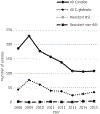Echinocandin resistance among Candida isolates at an academic medical centre 2005-15: analysis of trends and outcomes
- PMID: 29506044
- PMCID: PMC11963700
- DOI: 10.1093/jac/dky059
Echinocandin resistance among Candida isolates at an academic medical centre 2005-15: analysis of trends and outcomes
Abstract
Objectives: To identify the frequency of micafungin resistance among clinically significant isolates of Candida stored at our institution from 2005 to 2015. Chart review of patients with resistant isolates then informed the clinical setting and outcomes associated with these infections.
Methods: Clinical Candida isolates had been stored at -80°C in Brucella broth with 20% glycerol from 2005. Isolates were tested using broth microdilution to determine micafungin MICs. All Candida glabrata isolates and all isolates demonstrating decreased susceptibility to micafungin were screened for FKS mutations using a Luminex assay.
Results: In total, 3876 Candida isolates were tested for micafungin resistance, including 832 C. glabrata isolates. Of those, 33 isolates from 31 patients were found to have either decreased susceptibility to micafungin and/or an FKS mutation. C. glabrata accounted for the majority of these isolates. While bloodstream infections were found to have a very high mortality rate, isolates from other sites were uncommonly associated with 30-day mortality. Overall resistance rates were very low.
Conclusions: Echinocandin resistance in C. glabrata has been increasingly reported but rates at our institution remain very low. We hypothesize that a focus on antifungal stewardship may have led to these observations. Knowledge of local resistance patterns is key to appropriate empirical treatment strategies.
Figures
Similar articles
-
Rate of FKS Mutations among Consecutive Candida Isolates Causing Bloodstream Infection.Antimicrob Agents Chemother. 2015 Dec;59(12):7465-70. doi: 10.1128/AAC.01973-15. Epub 2015 Sep 21. Antimicrob Agents Chemother. 2015. PMID: 26392494 Free PMC article.
-
Spontaneous Mutational Frequency and FKS Mutation Rates Vary by Echinocandin Agent against Candida glabrata.Antimicrob Agents Chemother. 2018 Dec 21;63(1):e01692-18. doi: 10.1128/AAC.01692-18. Print 2019 Jan. Antimicrob Agents Chemother. 2018. PMID: 30373796 Free PMC article.
-
Antifungal drug susceptibility, molecular basis of resistance to echinocandins and molecular epidemiology of fluconazole resistance among clinical Candida glabrata isolates in Kuwait.Sci Rep. 2020 Apr 10;10(1):6238. doi: 10.1038/s41598-020-63240-z. Sci Rep. 2020. PMID: 32277126 Free PMC article.
-
Comparison of fks gene mutations and minimum inhibitory concentrations for the detection of Candida glabrata resistance to micafungin: A systematic review and meta-analysis.Mycoses. 2019 Sep;62(9):835-846. doi: 10.1111/myc.12929. Epub 2019 Jun 9. Mycoses. 2019. PMID: 31077631
-
Clinical perspectives on echinocandin resistance among Candida species.Curr Opin Infect Dis. 2015 Dec;28(6):514-22. doi: 10.1097/QCO.0000000000000215. Curr Opin Infect Dis. 2015. PMID: 26524326 Free PMC article. Review.
Cited by
-
Molecular investigations on Candida glabrata clinical isolates for pharmacological targeting.RSC Adv. 2022 Jun 14;12(27):17570-17584. doi: 10.1039/d2ra02092k. eCollection 2022 Jun 7. RSC Adv. 2022. PMID: 35765448 Free PMC article.
-
An update on the global treatment of invasive fungal infections.Future Microbiol. 2023 Nov;18(15):1095-1117. doi: 10.2217/fmb-2022-0269. Epub 2023 Sep 26. Future Microbiol. 2023. PMID: 37750748 Free PMC article. Review.
-
Direct Blood Culturing of Candida spp. on Solid Medium by a Rapid Enrichment Method with Magnetic Beads Coated with Recombinant Human Mannan-Binding Lectin.J Clin Microbiol. 2020 Mar 25;58(4):e00057-20. doi: 10.1128/JCM.00057-20. Print 2020 Mar 25. J Clin Microbiol. 2020. PMID: 32051260 Free PMC article.
-
A SERS Platform for Rapid Detection of Drug Resistance of Non-Candida albicans Using Fe3O4@PEI and Triangular Silver Nanoplates.Int J Nanomedicine. 2022 Aug 9;17:3531-3541. doi: 10.2147/IJN.S369591. eCollection 2022. Int J Nanomedicine. 2022. PMID: 35971445 Free PMC article.
-
Epidemiology of Invasive Candidiasis.Clin Epidemiol. 2024 Aug 28;16:549-566. doi: 10.2147/CLEP.S459600. eCollection 2024. Clin Epidemiol. 2024. PMID: 39219747 Free PMC article. Review.
References
-
- Beyda ND, John J, Kilic A et al. FKS mutant Candida glabrata: risk factors and outcomes in patients with candidemia. Clin Infect Dis 2014; 59: 819–25. - PubMed
Publication types
MeSH terms
Substances
Grants and funding
LinkOut - more resources
Full Text Sources
Other Literature Sources


